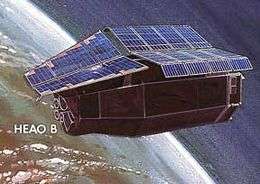Einstein Observatory
 Einstein Observatory | |
| Mission type | Astronomy |
|---|---|
| Operator | NASA |
| COSPAR ID | 1978-103A |
| SATCAT № | 11101 |
| Website | Einstein Observatory at NASA.gov |
| Mission duration | 4 years |
| Spacecraft properties | |
| Manufacturer | TRW |
| Dry mass | 3,130 kilograms (6,900 lb) |
| Start of mission | |
| Launch date | 13 November 1978, 05:24 UTC |
| Rocket | Atlas SLV-3D Centaur-D1AR |
| Launch site | Cape Canaveral LC-36B |
| End of mission | |
| Last contact | 17 April 1981 |
| Decay date | 26 May 1982 |
| Orbital parameters | |
| Reference system | Geocentric |
| Regime | Low Earth |
| Perigee | 465 kilometres (289 mi) |
| Apogee | 476 kilometres (296 mi) |
| Inclination | 23.5° |
| Period | 94.0 minutes |
| Epoch | 13 November, 1978 05:24:00 UTC |
Einstein Observatory (HEAO-2) was the first fully imaging X-ray telescope put into space and the second of NASA's three High Energy Astrophysical Observatories. Named HEAO B before launch, the observatory's name was changed to honor Albert Einstein upon its successfully attaining orbit.[1] [2]
Launch
The Einstein Observatory, HEAO-2, was launched on November 13, 1978, from Cape Canaveral, Florida, on an Atlas-Centaur SLV-3D booster rocket into a near-circular orbit with an initial altitude slightly above 500 km. Its orbital inclination orbit was 23.5 degrees. The Einstein Observatory satellite re-entered the Earth's atmosphere and burned up on March 25, 1982.[3]
Instrumentation
The Einstein Observatory carried a single large grazing-incidence focusing X-ray telescope that provided unprecedented levels of sensitivity (hundreds of times better than previously achieved) and arc-second angular resolution of point sources and extended objects. It had instruments sensitive in the 0.2 to 3.5 keV energy range. A collection of four focal-plane instruments was installed in the satellite: [4]
- HRI, or High Resolution Imaging camera, 0.15-3 keV
- IPC, or Imaging Proportional Counter, 0.4 to 4 keV
- SSS, or Solid State Spectrometer, 0.5 to 4.5 keV
- FPCS, or Bragg Focal Plane Crystal Spectrometer
- MPC, Monitor Proportional Counter, 1-20 keV
- BBFS, Broad Band Filter Spectrometer
- OGS, Objective grating spectrometer
References
- ↑ "HEA Heritage Missions: Einstein Observatory". cfa.harvard.edu. Retrieved 27 March 2014.
- ↑ "Einstein ObservatoryArticle Free Pass". britannica.com. Retrieved 27 March 2014.
- ↑ "Einstein Observatory (HEAO-2)". ecuip.lib.uchicago.edu. Retrieved 27 March 2014.
- ↑ "The Einstein /HEAO 2/ X-ray Observatory". adsabs.harvard.edu. Retrieved 27 March 2014.
See also
| Wikimedia Commons has media related to HEAO 2. |
- HEAO Program
- High Energy Astronomy Observatory 1
- High Energy Astronomy Observatory 3
- Timeline of artificial satellites and space probes